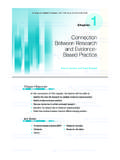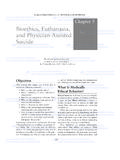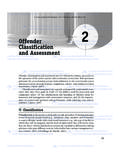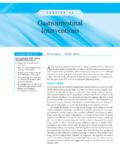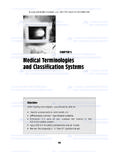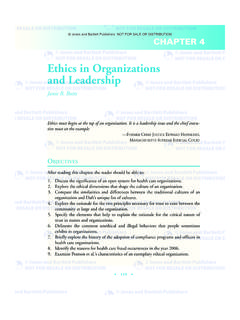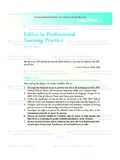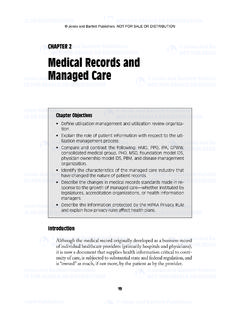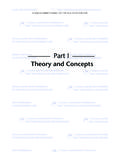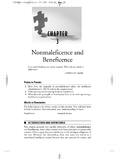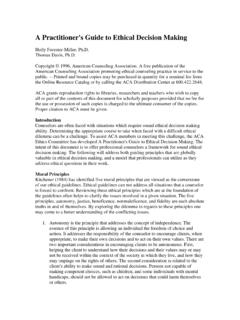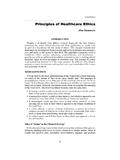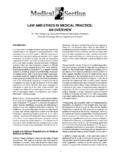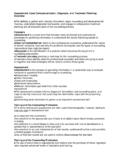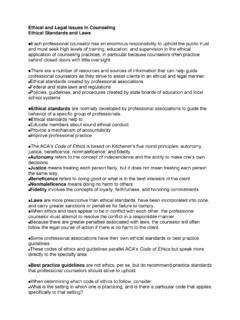Transcription of Critical Issues for Healthcare Organizations
1 235 PART IIIC ritical Issues for Healthcare OrganizationsPart III moves away from the individual and concentrates on healthcareinstitutions. It features examples of Issues that will be a part of their future inthe twenty-first century. Chapter 14 presents a discussion of the differencesbetween ethical Issues in a clinical situation and those faced by an organiza-tion. It includes the complexities of organizational ethics in the changinghealthcare environment. The chapter also shows how Organizations mustaddress clinical situations, legislation, and community responsibility and stillmake money. The author challenges you to think beyond the clinical arenaand to consider the broader view held by institutional ethics. Chapter 15 includes an overview of the institution s response to ethicalchallenge the ethics committee. It provides you with an understanding ofthe function, membership, and future challenges for these committees.
2 Thepractitioner s view section discusses some challenges that ethics committeesface because of financial concerns, technology demands, and scrutiny in end-of-life situations. Chapter 16 features managed care, an aspect of health care that is challeng-ing for both clinicians and Organizations . It begins with a review of the dis-tinctions between the types of managed care Organizations (MCOs). It thenpresents the ethical challenges that are part of such practices, such as utiliza-tion review, capitation, and physician incentives. The author also gives exam-ples of forces that will balance the negatives of MCOs and provides a managedcare model that includes ethics. This chapter should evoke much thought anddiscussion among your fellow professionals. Chapter 17 examines current and future ethical dilemmas for specific typesof Healthcare Organizations those that deal with prehospital and emergencycare.
3 The chapter suggests that emergency departments (EDs) are strugglingto be the safety net for the poor, and they might be losing the struggle. Itacquaints you with such controversial areas as the need for paternalism,assisted suicides and emergency room practices, and prehospital DNR addition, the need for security for those who work in the ED, the practice ofteaching on the newly dead, and the ability to conduct research on criticalpatients are presented as ethical concerns that will continue into the future. Another specific organization that is included in Part III is the home careindustry, which will be discussed in Chapter 18. Technology s almost miraculousability to prolong life has led to an increasing problem for Healthcare organiza-tions and individuals. Some patients require care beyond the ordinary, andhome health care tries to provide this care. The chapter provides informationon the home health model and its history of dealing with medically fragile, 2/29/08 4:34 PM Page 235 Jones and Bartlett Publishers.
4 NOT FOR SALE OR DISTRIBUTION236 HEALTHCAREETHICS technology-dependent adults and children. Ongoing ethical Issues for homehealth are stressed, and the impact of the aging boomers on its future isincluded for your consideration. Chapter 19 introduces a global ethics issue for Healthcare Organizations . Itasks the question, what is the role of spirituality in a Healthcare organiza-tion? The chapter explores the definition of spiritualityin general, its applica-tion to work, and reasons why it will be an issue for Healthcare organizationsin the twenty-first century. It also includes the effect of the spirit on transitionand the ethical theories and principles that support spirituality in the health-care organization . Part III does not include every future ethical situation faced by healthcareorganizations. However, it does provide a beginning for considering issuesthat will affect all these Organizations .
5 It also gives an overview of some of thequandaries faced by specific Healthcare Organizations , such as home healthand the emergency department. In this part of the text, you will be challengedto think outside of the clinical box and consider ethics from the organiza-tion s view. 2/29/08 4:34 PM Page 236 Jones and Bartlett Publishers. NOT FOR SALE OR DISTRIBUTION237 CHAPTER 14 Healthcare Institutional Ethics:Broader than Clinical EthicsCarrie Zoubul*OVERVIEWThis chapter provides an examination of the current and future ethics Issues thatchallenge Healthcare institutions. They are addressed from several viewpoints,mirroring the model for this text. For example, Issues facing individual managersin terms of their need for practicing ethical integrity are presented (individual). Issues involving nonprofit institutions as they struggle with providing care andmaking payroll and the need for Healthcare institutions to provide proactive careare discussed (organizational).
6 Finally, the schizophrenic view of American societyabout its Healthcare system is presented in a matter that fosters understanding ofthis often complex issue (society). This chapter will greatly increase your under-standing of the business side of health care and the ethical Issues it faces in problems have dominated the ethical concerns of hospitals andother Healthcare institutions for the past 35 years. Clinical Issues such as thetermination of treatment, patient autonomy, informed consent, confidentiality,advance directives, and other individual case-based Issues have occupied cen-ter stage. In the late 1980s and early 1990s, the focus of bioethics began tobroaden. With the onset of rapid change in the structure of the healthcaredelivery system, many institutions began to recognize and address ethicalissues inherent in business practices, corporations, and managed care organi-zations. As managed care took its place as primary mode of Healthcare deliv-ery, questions were raised about how to expand bioethics to addressinstitutional structure and the business aspects of health focus on clinical, business, and ethical matters eventuallybegan to give way to network concerns.
7 Networks comprised of institutions,physician Organizations , financing mechanisms, other health businesses, andcommunity Organizations began to emerge. This change resulted in new andorganizationally complex ethical dilemmas that demanded different analyticalframeworks and broader ethical analysis. In the bioethics literature, this areaof inquiry has become known as organizational ethics, applicable to bothindividual Healthcare institutions ( , hospitals) and to the other entities* Revised from D. Brodeur, Health Care Institutional Ethics: Broader then Clinical Ethics, inHealth Care Ethics: Critical Issues for the 21st Century. Original ed., 1998, edited by John. and David C. Thomasma. Sudbury, MA: Jones and Bartlett, 2/29/08 4:34 PM Page 237 Jones and Bartlett Publishers. NOT FOR SALE OR DISTRIBUTION238 HEALTHCAREETHICS that make up the modern Healthcare definitions of organiza-tional ethics have been formulated.
8 Some examples include: it aims toenhance the overall ethics of an organization with the goal of changing the cli-mate and then the culture of the organization ; 2it deals with an organiza-tion s positions and behavior relative to individuals (including patients,providers, and employees), groups, communities served by the organization ,and other Organizations ; 3it is described as the intentional use of values toguide the decisions of a system; 4and it focuses on the ethical climate of theentire encompasses and integrates all other ethicsresources and activities within an organization . 5 Today, Healthcare networks and their member institutions constitute com-plex, interdependent systems of patients, families, professionals, payers,processes, communities, and businesses. These multiple players interact inintricate ways. Their daily activities, missions, institutional values, strategicgoals, and their impact on the community and the community s health statusare ethically significant.
9 The bioethical principles of autonomy, beneficence,nonmaleficence, and justice as traditionally formulated may not be sufficientto address the ethical Issues that arise. Although these principles have theirplace, questions of distributive justice demand greater attention and the prin-ciples of business ethics, such as honesty, truthfulness, and keepingpromises 6may also be patient care is still the focus of much of an institution s activity, theneed to address clinical bioethical Issues remains a priority. These Issues areaddressed in other chapters of this book. This chapter focuses on the ethicalissues that Healthcare network and institutional administrators (and some-times trustees) need to address from a personal, institutional, and communalperspective. These include justice Issues (social, distributive, and commuta-tive), the promotion of the common good, the role of the community in thehealthcare system, preservation of human resources, the definition of health,the role of law and government regulation, promoting access to quality Healthcare , conflicts of interest, and the allocation of resources, to name a few.
10 Thischapter will not outline a comprehensive theory of justice, argue for a processof allocating or rationing resources, or define the concept of health. Rather, itwill attempt to outline important considerations and describe potential ethicalissues and value conflicts that arise in Healthcare networks and institutionsat the organizational Organizations play an important public role in their communi-ties, providing medical care, medical education, and significant employmentopportunities. Trustees and managers confront ethical Issues that involveclinical matters, corporate and institutional structure, strategic direction, per-sonal and personnel commitments, and the public nature of health FROM A CLINICAL FOCUS TO INCORPORATE ORGANIZATIONAL CONCERNSFor many years, Healthcare institutions have been expected to be attentiveto clinical ethics Issues that arise in the context of patient care.
